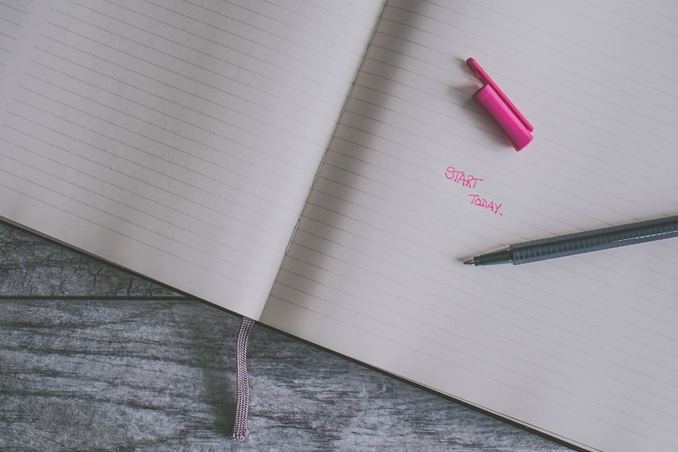Authored by Amber Hanson, LN
Have you ever had that experience of pulling into your garage after work and realizing you have no idea how you got there? It is kind of like your brain is on autopilot. This is an example of habit in action. When you do the same thing day after day your brain doesn’t need to think as much about doing, it just does. In the case of driving it is a little scary to check-out like that but for something like going on a run when you get up in the morning or taking a few deep breathes when you start to feel stressed out, habit is great.
Contrast that with motivation. Motivation can be powerful as well – it is the desire to do something. I like to think of it as the spark. The thing with motivation is that for most people it is fleeting. Take, for example, reading an article about someone completing their first half marathon. The article is inspiring, it makes you want to run a half marathon. You decide tomorrow morning you will get up early and go for a run. Fast forward to the next morning when your alarm is going off an hour earlier than usual – are you still feeling motivated? For some the answer is yes, they hop out of bed and go for a run. For many of us the answer is no, hitting the snooze button is much more appealing in the moment.
Back to the driving example, you didn’t always work at the same place or live in the same house, so your brain needed to learn the driving route before it could be habit. It is the consistent repeating of a behavior - over and over and over again - that turns it into habit. The good news? You can teach yourself new habits! The not so good news, it is going to take some practice. But the reward is that new behaviors switch from fleeting motivation to autopilot habits.
The formation of a habit always starts with a cue (like leaving work), followed by a response (driving home), and a reward (seeing your family). Responding to a cue in the same way over and over creates a habit. Do you remember when you first started at your new job location? You had to think about which streets to take and when to turn, pay attention to the locations of traffic signals and signs, and think about not driving to your old job location. Maybe you even turned the radio off the first time you drove the route so your brain could concentrate with less distractions because it was working hard to figure out this new thing. That experience of first driving to a new job is an example of building or changing a habit.
To form a new healthy habit, you need to practice your response to a cue repeatedly until it becomes automatic. To break an unhealthy habit, you need to become aware of your cues so you can stop the automatic behavior that follows. To develop a habit like running in the morning the cue of the alarm clock needs to elicit the response of getting out of bed and changing into running clothes. You need to break the response of hitting the snooze button. The reward for running might be more energy and a sense of accomplishment. Hitting the snooze button on the other hand might feel good in the moment but the reward is short lived.
Thankfully a number of people have studied habit and habit changes and pulled together some tips to help the rest of us. A few of my favorite come from Gretchen Rubin’s book Better Than Before, a book full of tips on breaking and establishing habits. Here are a few strategies to try when changing a habit with examples.
Contrast that with motivation. Motivation can be powerful as well – it is the desire to do something. I like to think of it as the spark. The thing with motivation is that for most people it is fleeting. Take, for example, reading an article about someone completing their first half marathon. The article is inspiring, it makes you want to run a half marathon. You decide tomorrow morning you will get up early and go for a run. Fast forward to the next morning when your alarm is going off an hour earlier than usual – are you still feeling motivated? For some the answer is yes, they hop out of bed and go for a run. For many of us the answer is no, hitting the snooze button is much more appealing in the moment.
Back to the driving example, you didn’t always work at the same place or live in the same house, so your brain needed to learn the driving route before it could be habit. It is the consistent repeating of a behavior - over and over and over again - that turns it into habit. The good news? You can teach yourself new habits! The not so good news, it is going to take some practice. But the reward is that new behaviors switch from fleeting motivation to autopilot habits.
The formation of a habit always starts with a cue (like leaving work), followed by a response (driving home), and a reward (seeing your family). Responding to a cue in the same way over and over creates a habit. Do you remember when you first started at your new job location? You had to think about which streets to take and when to turn, pay attention to the locations of traffic signals and signs, and think about not driving to your old job location. Maybe you even turned the radio off the first time you drove the route so your brain could concentrate with less distractions because it was working hard to figure out this new thing. That experience of first driving to a new job is an example of building or changing a habit.
To form a new healthy habit, you need to practice your response to a cue repeatedly until it becomes automatic. To break an unhealthy habit, you need to become aware of your cues so you can stop the automatic behavior that follows. To develop a habit like running in the morning the cue of the alarm clock needs to elicit the response of getting out of bed and changing into running clothes. You need to break the response of hitting the snooze button. The reward for running might be more energy and a sense of accomplishment. Hitting the snooze button on the other hand might feel good in the moment but the reward is short lived.
Thankfully a number of people have studied habit and habit changes and pulled together some tips to help the rest of us. A few of my favorite come from Gretchen Rubin’s book Better Than Before, a book full of tips on breaking and establishing habits. Here are a few strategies to try when changing a habit with examples.
- Monitoring. This might look like writing what you eat in a food diary or tracking the miles you run during your workout. Monitoring helps you pay attention to things you want to change, keeping it top of mind. A monitoring tool like a food diary can also help you discover cues to certain behaviors.
- Accountability. This could be making a workout date with a friend or scheduling an appointment with a licensed nutritionist to improve your diet. Having an appointment makes it harder to make excuses not to do something. And when working with a professional, if you are struggling with change, they can help you break the change down into more manageable pieces and help you work through what is blocking your progress.
- Build a Foundation. This is the idea that if you have some basics in place it is easier to cultivate new healthy behaviors. To build a strong foundation, I often encourage clients to start a morning routine. It can be as easy as making the bed every morning, drinking a glass of water before having coffee, or stretching for 5 minutes after getting out of bed. Consistently doing these smaller behaviors proves to yourself you can establish a habit. And doing them first thing in the morning gives that sense of accomplishment for the whole day which can lead to additional healthy choices throughout the day.


 RSS Feed
RSS Feed